“For years, Lydia Huayllas, 48, has worked as a cook at base camps and mountain-climbing refuges on the steep, glacial slopes of Huayna Potosi, a 19,974-foot (6,088-meter) Andean peak outside of La Paz, Bolivia. But two years ago, she and 10 other Aymara indigenous women, ages 42 to 50, who also worked as porters and cooks for mountaineers, put on crampons – spikes fixed to a boot for climbing – under their wide traditional skirts and started to do their own climbing. These women have now scaled five peaks – Acotango, Parinacota, Pomarapi and Huayna Potosi as well as Illimani, the highest of all – in Bolivia's Cordillera Real range. All are higher than 19,500 feet (6,000 meters) above sea level. The women climb in their traditional “cholita” garb, but trade in their bowler hats for helmets, and use modern equipment including ropes, harnesses, crampons and boots. One advantage the women have to outsiders who come to the Andes to climb is that highland Bolivians are already well acclimated to the thin air at high altitudes. The short-term goal for the group is to climb eight mountains higher than 19,700 feet (6,000 meters). The group's ultimate dream is to plant a Bolivian flag on the summit of Aconcagua, the highest mountain outside of Asia at 22,841 feet (6,961 meters), located in the Argentine Andes near the border with Chile”. – David Mercado via Reuters
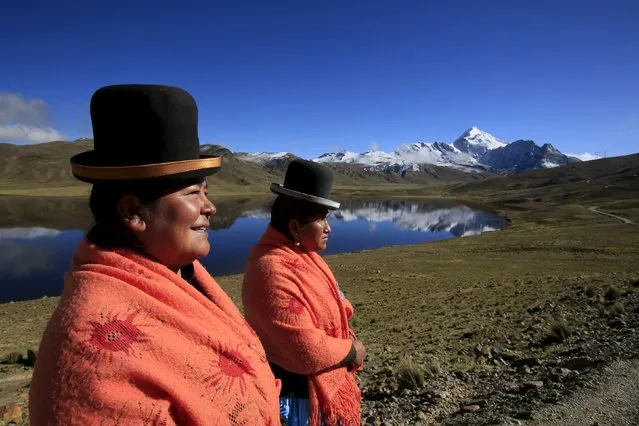
Aymara indigenous women Lidia Huayllas, 48, (L) and Dora Magueno, 50, stand near Milluni lake, with the Huayna Potosi mountain in the background, Bolivia April 6, 2016. For years, Lydia Huayllas has worked as a cook at base camps and mountain-climbing refuges on the steep, glacial slopes of Huayna Potosi, a 19,974-foot (6,088-meter) Andean peak outside of La Paz, Bolivia. But two years ago, she and 10 other Aymara indigenous women, ages 42 to 50, who also worked as porters and cooks for mountaineers, put on crampons – spikes fixed to a boot for climbing – under their wide traditional skirts and started to do their own climbing. (Photo by David Mercado/Reuters)
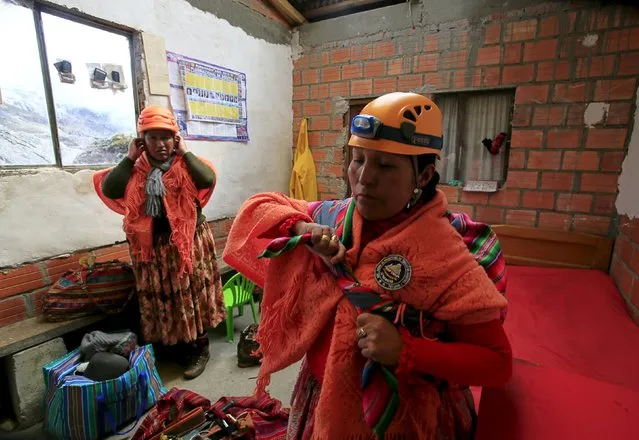
Aymara indigenous women prepare at the Huayna Potosi mountain refuge, Bolivia April 6, 2016. (Photo by David Mercado/Reuters)
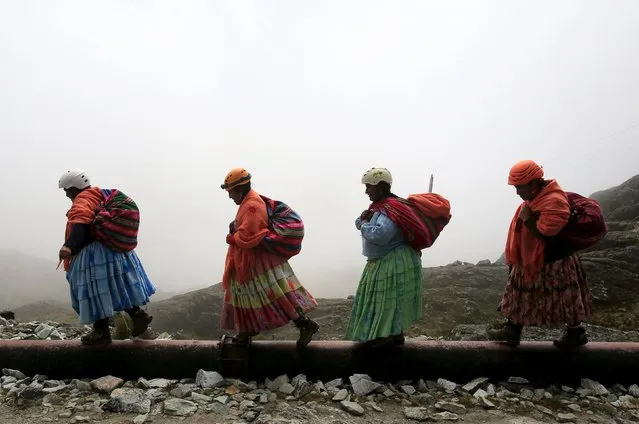
Aymara indigenous women walk toward Huayna Potosi mountain, Bolivia April 6, 2016. (Photo by David Mercado/Reuters)
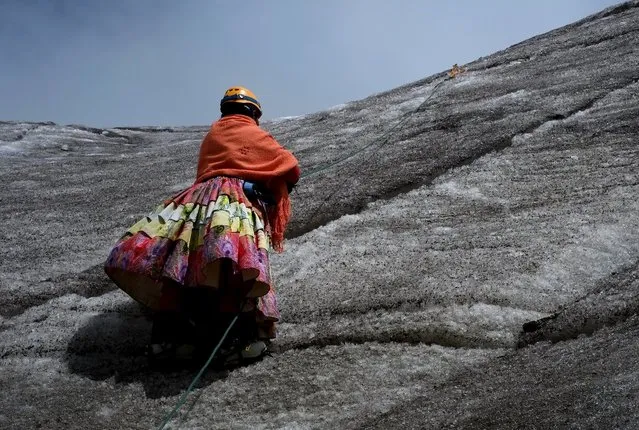
An Aymara indigenous woman practises climbing on the Huayna Potosi mountain, Bolivia April 6, 2016. (Photo by David Mercado/Reuters)

An Aymara indigenous woman walks on the Huayna Potosi mountain, Bolivia April 6, 2016. (Photo by David Mercado/Reuters)
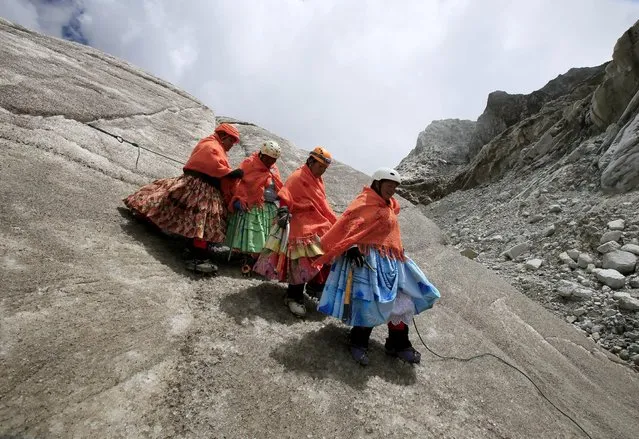
Aymara indigenous women practise descending on a glacier at the Huayna Potosi mountain, Bolivia April 6, 2016. (Photo by David Mercado/Reuters)
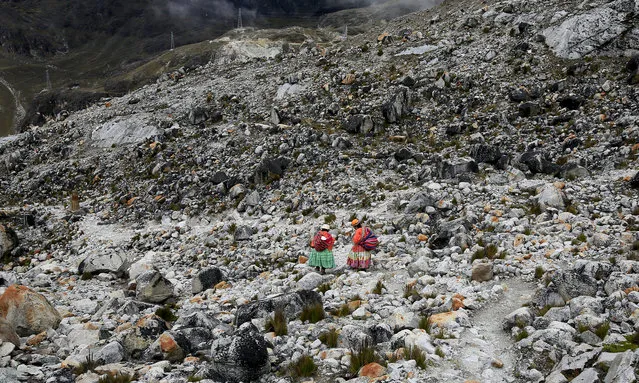
Aymara indigenous women descend after practicing on the glacierat the Huayna Potosi mountain, Bolivia April 6, 2016. (Photo by David Mercado/Reuters)
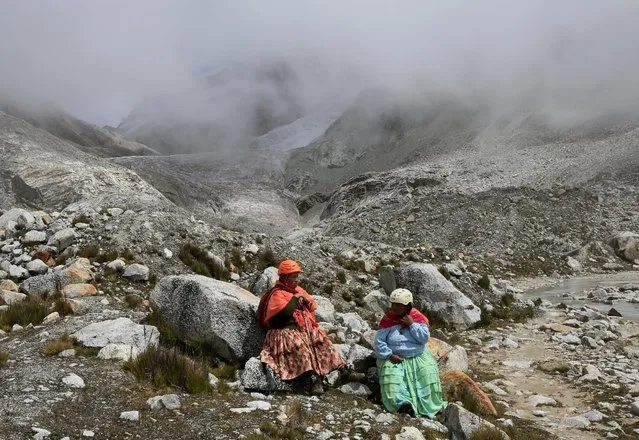
Aymara indigenous women rest at the Huayna Potosi mountain, Bolivia April 6, 2016. (Photo by David Mercado/Reuters)
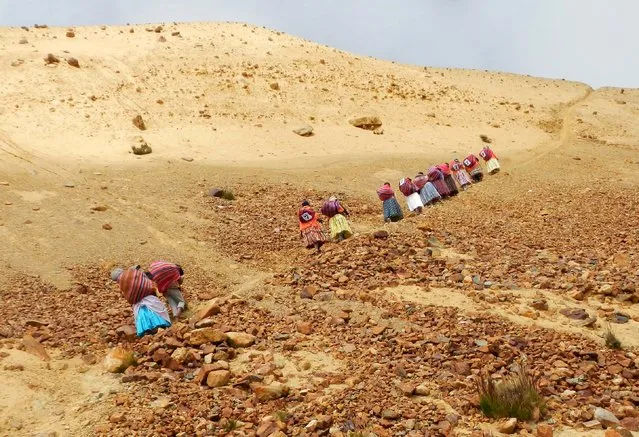
Aymara indigenous women climb the Illimani mountain, on the outskirts of La Paz, Bolivia, April 16, 2016. (Photo by David Mercado/Reuters)
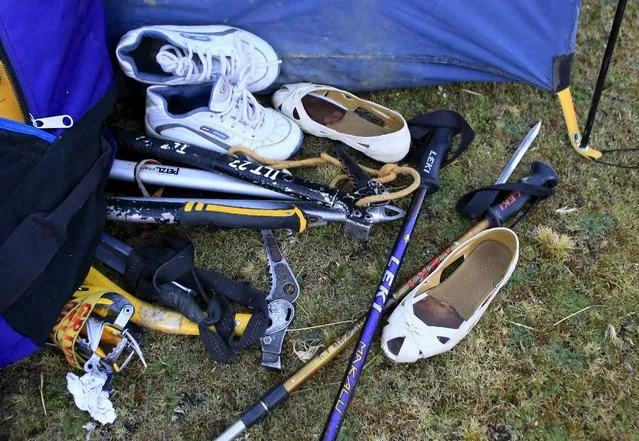
Climbing gear is seen at the base camp of Aymara indigenous women mountaineers at the Illimani mountain, on the outskirts of La Paz, Bolivia, April 16, 2016. (Photo by David Mercado/Reuters)
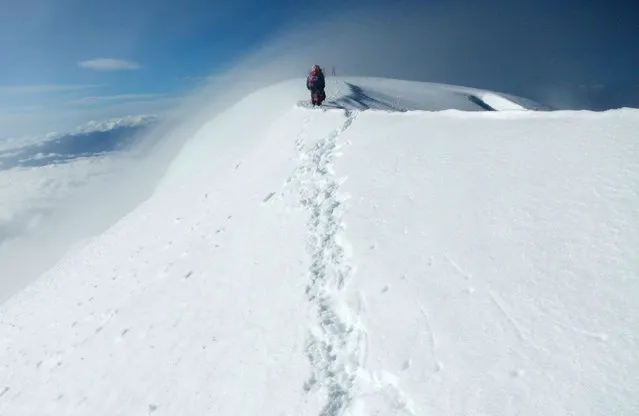
Aymara indigenous women climb the Illimani mountain, on the outskirts of La Paz, Bolivia, April 17, 2016. (Photo by David Mercado/Reuters)
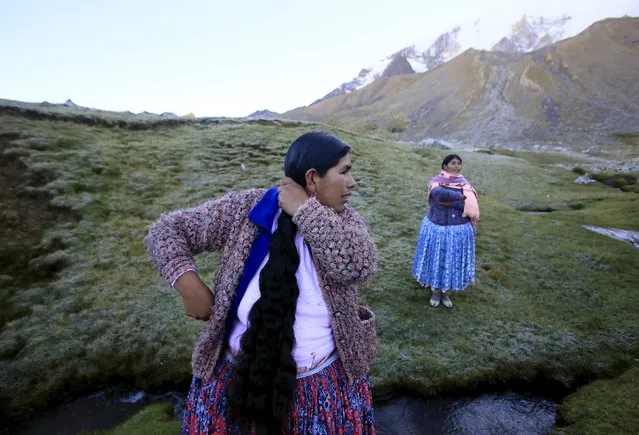
Aymara indigenous women fix their hair before ascending the Illimani mountain, on the outskirts of La Paz, Bolivia, April 16, 2016. (Photo by David Mercado/Reuters)
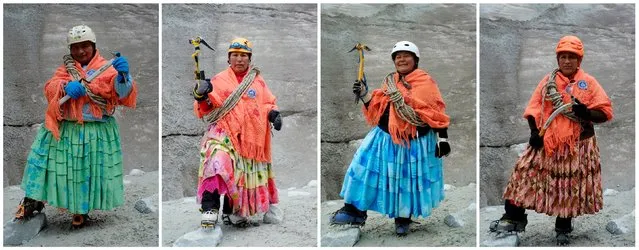
Combination picture shows Aymara indigenous women (L-R) Domitila Alana, 42, Bertha Vedia, 48, Lidia Huayllas, 48, and Dora Magueno, 50, posing for a photograph at the Huayna Potosi mountain, Bolivia April 6, 2016. (Photo by David Mercado/Reuters)
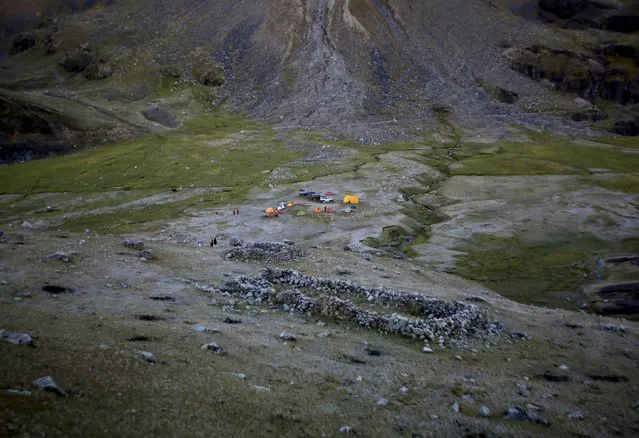
The base camp of the Aymara indigenous women mountaineers is seen from the Illimani mountain, on the outskirts of La Paz, Bolivia, April 16, 2016. (Photo by David Mercado/Reuters)
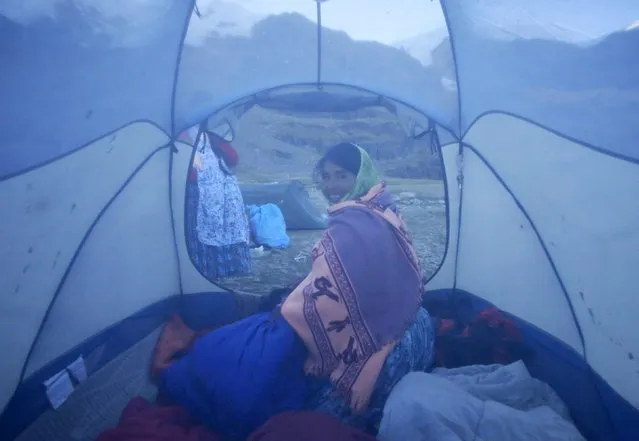
Aymara indigenous woman Rufina Llusco sits in her tent before ascending the Illimani mountain, on the outskirts of La Paz, Bolivia, April 16, 2016. (Photo by David Mercado/Reuters)
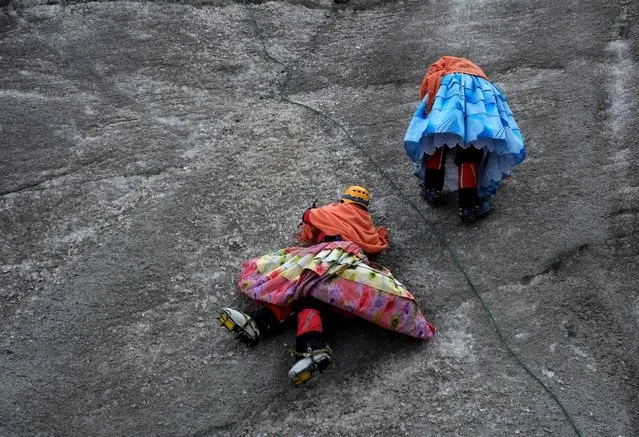
Aymara indigenous women practise on a glacier of the Huayna Potosi mountain on the outskirts of La Paz, Bolivia, April 6, 2016. (Photo by David Mercado/Reuters)
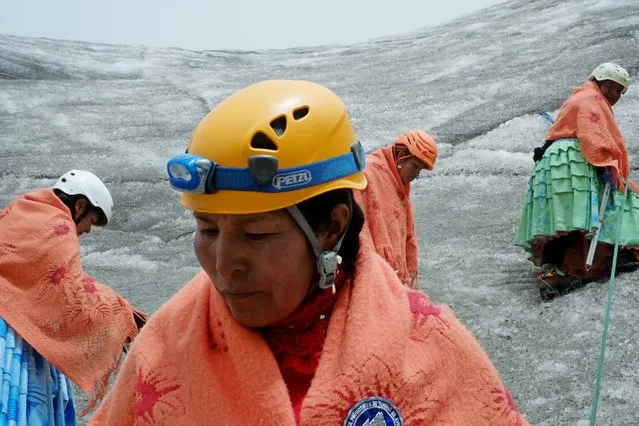
Aymara indigenous women are seen at the Huayna Potosi mountain, Bolivia April 6, 2016. (Photo by David Mercado/Reuters)
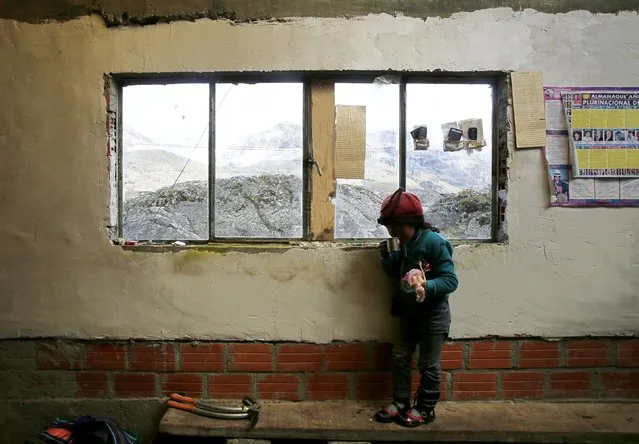
A girl stands in the Huayna Potosi mountain refuge, Bolivia April 6, 2016. (Photo by David Mercado/Reuters)
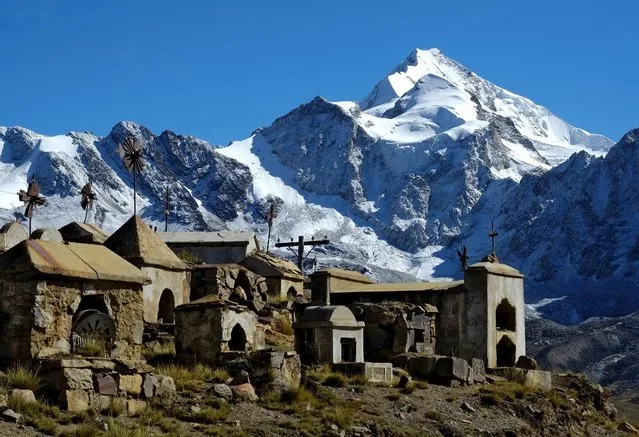
Milluni cemetery is seen near the Huayna Potos mountain, Bolivia April 6, 2016. (Photo by David Mercado/Reuters)
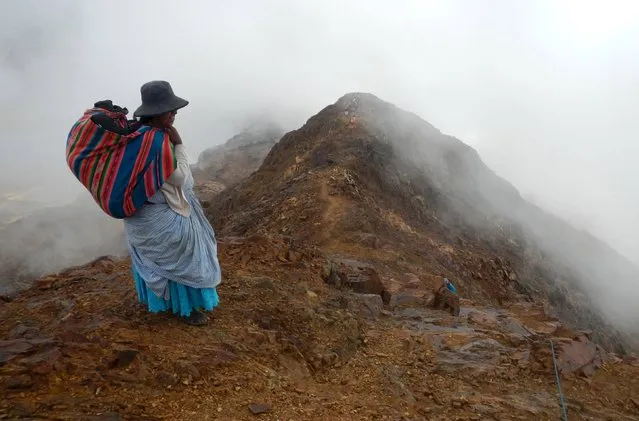
A porter stands at the bottom of the Illimani mountain, on the outskirts of La Paz, Bolivia, April 16, 2016. (Photo by David Mercado/Reuters)

Aymara indigenous women Lidia Huayllas, 48, (L) and Dora Magueno, 50, stand near Milluni lake, with the Huayna Potosi mountain in the background, Bolivia April 6, 2016. For years, Lydia Huayllas has worked as a cook at base camps and mountain-climbing refuges on the steep, glacial slopes of Huayna Potosi, a 19,974-foot (6,088-meter) Andean peak outside of La Paz, Bolivia. But two years ago, she and 10 other Aymara indigenous women, ages 42 to 50, who also worked as porters and cooks for mountaineers, put on crampons – spikes fixed to a boot for climbing – under their wide traditional skirts and started to do their own climbing. (Photo by David Mercado/Reuters)

Aymara indigenous women prepare at the Huayna Potosi mountain refuge, Bolivia April 6, 2016. (Photo by David Mercado/Reuters)

Aymara indigenous women walk toward Huayna Potosi mountain, Bolivia April 6, 2016. (Photo by David Mercado/Reuters)

An Aymara indigenous woman practises climbing on the Huayna Potosi mountain, Bolivia April 6, 2016. (Photo by David Mercado/Reuters)

An Aymara indigenous woman walks on the Huayna Potosi mountain, Bolivia April 6, 2016. (Photo by David Mercado/Reuters)

Aymara indigenous women practise descending on a glacier at the Huayna Potosi mountain, Bolivia April 6, 2016. (Photo by David Mercado/Reuters)

Aymara indigenous women descend after practicing on the glacierat the Huayna Potosi mountain, Bolivia April 6, 2016. (Photo by David Mercado/Reuters)

Aymara indigenous women rest at the Huayna Potosi mountain, Bolivia April 6, 2016. (Photo by David Mercado/Reuters)

Aymara indigenous women climb the Illimani mountain, on the outskirts of La Paz, Bolivia, April 16, 2016. (Photo by David Mercado/Reuters)

Climbing gear is seen at the base camp of Aymara indigenous women mountaineers at the Illimani mountain, on the outskirts of La Paz, Bolivia, April 16, 2016. (Photo by David Mercado/Reuters)

Aymara indigenous women climb the Illimani mountain, on the outskirts of La Paz, Bolivia, April 17, 2016. (Photo by David Mercado/Reuters)

Aymara indigenous women fix their hair before ascending the Illimani mountain, on the outskirts of La Paz, Bolivia, April 16, 2016. (Photo by David Mercado/Reuters)

Combination picture shows Aymara indigenous women (L-R) Domitila Alana, 42, Bertha Vedia, 48, Lidia Huayllas, 48, and Dora Magueno, 50, posing for a photograph at the Huayna Potosi mountain, Bolivia April 6, 2016. (Photo by David Mercado/Reuters)

The base camp of the Aymara indigenous women mountaineers is seen from the Illimani mountain, on the outskirts of La Paz, Bolivia, April 16, 2016. (Photo by David Mercado/Reuters)

Aymara indigenous woman Rufina Llusco sits in her tent before ascending the Illimani mountain, on the outskirts of La Paz, Bolivia, April 16, 2016. (Photo by David Mercado/Reuters)

Aymara indigenous women practise on a glacier of the Huayna Potosi mountain on the outskirts of La Paz, Bolivia, April 6, 2016. (Photo by David Mercado/Reuters)

Aymara indigenous women are seen at the Huayna Potosi mountain, Bolivia April 6, 2016. (Photo by David Mercado/Reuters)

A girl stands in the Huayna Potosi mountain refuge, Bolivia April 6, 2016. (Photo by David Mercado/Reuters)

Milluni cemetery is seen near the Huayna Potos mountain, Bolivia April 6, 2016. (Photo by David Mercado/Reuters)

A porter stands at the bottom of the Illimani mountain, on the outskirts of La Paz, Bolivia, April 16, 2016. (Photo by David Mercado/Reuters)
22 Apr 2016 12:33:00,
post received
0 comments
